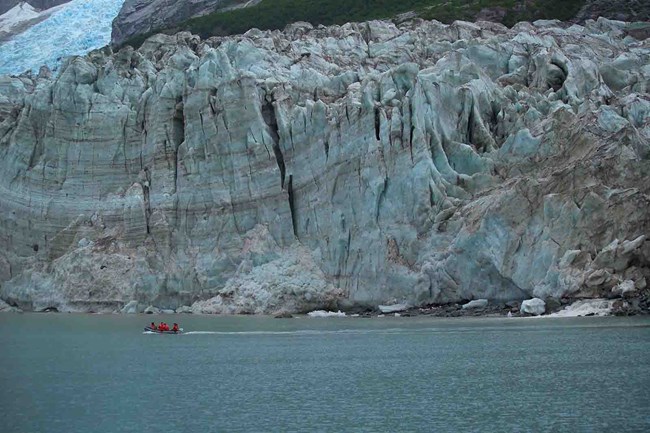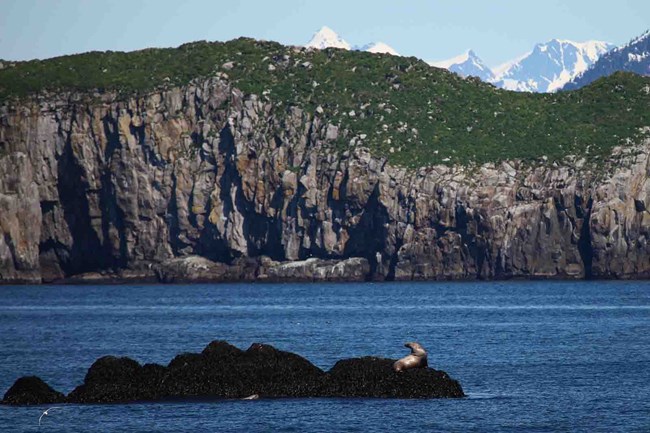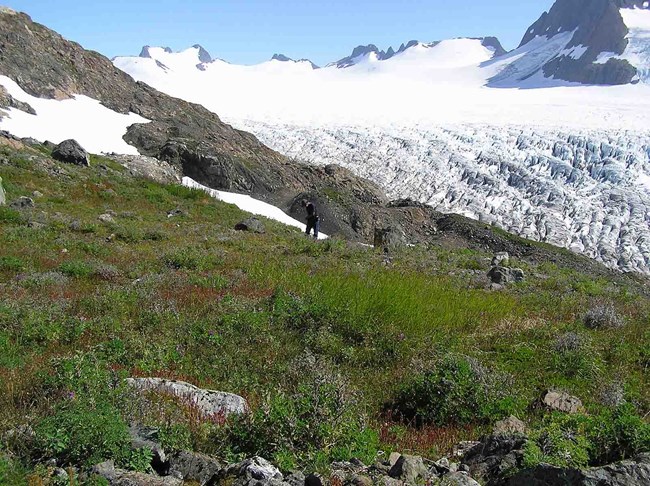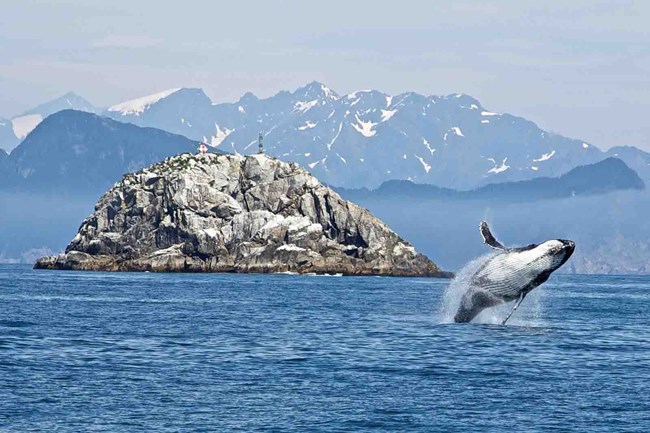
NPS/Jim Pfeiffenberger
Climate
Warm ocean currents flowing through the Gulf of Alaska result in a climate characterized by cool summers and mild winters. Kenai Fjords National Park, divided by the Kenai Mountains, lies in both the maritime and transitional Cook Inlet zone. The coast has a typical maritime climate, with cool rainy summers and snowy, storm-driven winters.
Geology
The outer coast of Kenai Fjords National Park rides the exposed edge of the North American Plate, where the Pacific Plate is subducting beneath it. As a result, the region is subject to earthquakes of moderate frequency and intensity with resulting landslides onto the ocean floor and uplift and subsidence on land. The beautiful circular bays of the Aialik, Harris, and McCarty peninsulas are drowned cirques of the Chugach Mountains, which were partially submerged by tectonic subsidence during the Holocene. The ghost forests in Beauty Bay are remnants from subsidence and saltwater incursion following the 1964 earthquake.
Pleistocene and Holocene glaciations are among the major forces shaping the landscape and ecological processes of the coastline. Warming and cooling cycles over the last 100,000 years have resulted in multiple glacial advances and retreats. Ice sheets of Naptown age (7,000-1,100 years before present) extended 50-100 miles into the Gulf of Alaska beyond the current coastline. These glaciations carved off all soft and loose material, leaving steep polished bedrock walls and deep submarine valleys along the Kenai Fjords coastline. More recent glaciations reached their maximal extent in the 19th century and are currently undergoing a dramatic retreat.

NPS/Jim Pfeiffenberger
Coastal and Marine Resources
The coast is a series of deep narrow fjords cutting into the Kenai Mountains, spaced by even steeper rock cliffs along the exposed outer coast. More than a third of the park’s coast is affected by high-energy waves, primarily driven by offshore winds and Gulf storms. An additional quarter of the coast has low energy, protected coves and lagoons, several of which support salt marshes.
Hydrology
There are more than 150 lakes and ponds in Kenai Fjords NP with a combined surface area exceeding 4,200 ac (1,700 ha). Recent deglaciations have exposed new streams and lakes, which are being rapidly colonized by salmon. Delight, Desire, and Delusion lakes, on the east side of McCarty Fiord, are three of the larger lakes, and all are currently used by salmon.
Freshwater streams on the coast tend to be short, steep, and generally “flashy,” in that the flows respond rapidly to rain events, which can be extreme along this coast. Glacial streams, formed of meltwater from grounded and hanging glaciers, also tend to be short, but are of lower gradient than most of the clear water streams. Primary glacial streams flow into Nuka Bay, Northwestern Lagoon, and Aialik Bay. Exit Creek flows from the terminus of Exit Glacier to the confluence with the Resurrection River, and is a focal point for the park due to its accessibility.

NPS/Alaska Natural Heritage Program
Flora and Fauna
Plant communities of Kenai Fjords NP are largely shaped by glacial history and their proximity to the coast. Gravel beaches grade into a supratidal community of beach ryegrass, beach pea, and seaside sandplant. Protected lagoons, like those at the heads of James and Beauty Bay, have rich beds of goose tongue, a favorite spring food for bears. Exposed rocky cliffs have tufts of grasses and perennial forbs, some richly fertilized and aerated by puffin nests.
Alder stands and Sitka spruce/hemlock forests occur just above the high-tide zone. Alder is a rapid colonizer in disturbed areas, following avalanche tracks from the alpine down to tide line. Sitka spruce can establish in deglaciated terrain within 20 years of ice retreat. Young (early seral) Sitka spruce stands are characterized by uniform-aged trees and a thin moss layer. Older stands that survived the Last Glacial Maximum have spruce of varying ages and a thick moss layer, with alder, salmonberry, highbush blueberry, and devil’s club in openings.
Alpine tundra at the higher elevations quickly grades into bare rock and ice. Nunataks, or isolated mountain ridges, are present across the Harding Icefield and support plant communities in various stages of development. Sites that remain snow covered for most of the year remain sparsely vegetated or unvegetated, while those that melt out sooner support sedges, grasses, and forbs that provide forage for mountain goats and other mammals. Glacial retreats have left behind wide valleys with broad braided floodplains and stands of alder and willows on the coast, and cottonwood in the Exit Creek floodplain.

NPS/Jim Pfeieffenberger
Twenty-nine species of terrestrial mammals are documented or are expected to occur within the park. Among these, mountain goat, moose, black bear, brown bear, hoary marmot, snowshoe hare, porcupine, ermine, red squirrel, and red-backed vole are the species most frequently encountered. Also present, but less frequently observed, are wolf, coyote, lynx, wolverine, marten, flying squirrel, beaver, river otter, little brown myotis bat, and mink.
Two-hundred-eighteen species of birds are documented or expected to occur within the park. No federally listed species are known to occur in terrestrial portions of the park, however, several State of Alaska species of special concern are present, including the Kenai Peninsula population of brown bear, Black Oystercatcher, Townsend’s Warbler, Gray-cheeked Thrush, Blackpoll Warbler, and Olive-sided Flycatcher.

NPS/Kaitlin Thoresen
Although some fisheries surveys have been conducted in nearshore waters, there have been no systematic surveys for freshwater fish. King, chum, coho, pink, and sockeye salmon are known to spawn in numerous park streams. Three-spine stickleback and Dolly Varden char were commonly found in park streams and lakes.
The coastal realm supports many species of fish, including rockfish, halibut, lingcod, and pollock. Forage fish, such as capelin and herring, and several species of shrimp abound. Commercial fishing for salmon and halibut occurs in the fjords and in lagoons such as James and McCarty in McCarty Fjord.
The Gulf current provides a migratory path for humpback, grey, minke, and fin whales in spring and fall, and a quasi resident pod of killer whales frequents outer Resurrection Bay. Sea otters, northern fur seals, Steller sea lions, harbor seals, harbor porpoises, and Dall’s porpoises also use the coast.
What's Happening in Kenai Fjords National Park
Last updated: December 8, 2025
